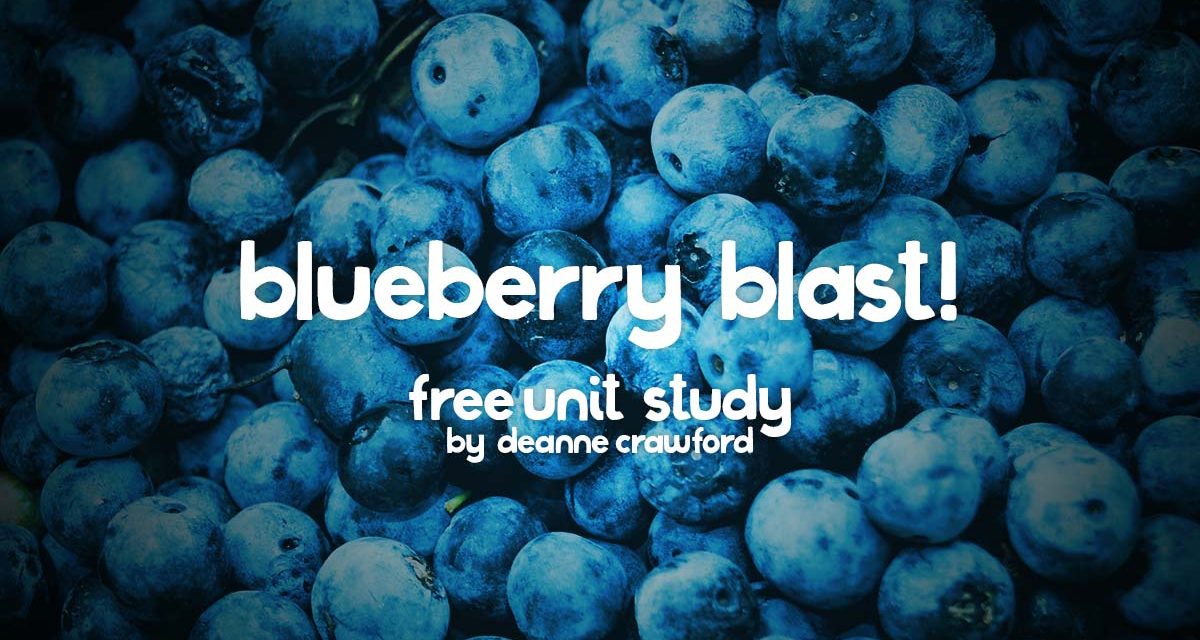Who Am I?
Native Americans called me the star-berry.
Colonial America prized me as a stain for clothing and homes.
Civil War soldiers fell in love with my sweetness, taking me ‘canned’ into the fields.
The U.S is the number 1 producer of me, followed closely by Canada.
Can you guess who I am?
Welcome to our July unit study celebrating the Blueberry! Blueberries have a rich history in North America from the earliest discoveries of the grown in the wild berry to the cultivated berry prevalent across the world. Native American tribes were first to describe the blossom end of each berry, the calyx, as a perfect five-pointed star. The elders of the tribe shared stories of a great spirit that sent “star berries” to relieve their children’s hunger during a famine. More than a food source, the blueberry plant also had medicinal uses. Blueberry tea was thought to build up the blood and was often used to relieve labor pains, while a thick blueberry juice soothed coughs.
Our Canadian neighbors also discovered great worth in the blueberry. In 1605, French explorer and founder of Quebec (1615), Samuel Champlain noted that the Huron people pressed and dried blueberries into cakes, as well as ate them raw. They also would grind them and make a type of flour. He described Algonquin women drying “blues” which they used in cornmeal bread. Useful as blueberries were, however, no one actually grew them on purpose until the early 1900s when Elizabeth Coleman White, reading an article from the United States Department of Agriculture (USDA) she became inspired to enlarge the growth of wild blueberries on her family’s land. In his research, botanist Fredrick Corville, discovered the key to successful blueberry growth was acidic soil and encouraged farmers to test his theories by expanding blueberry bush growth. Joining forces, Mr. Corville and Ms. White worked together to create multiple varieties of the fruit we know and love today. Read more about the fascinating beginnings of the cultivated global blueberry from NPR.
Blueberries are not only a favorite of humans. Ripe blueberries are considered a diet staple for North American black and grizzly bears. While many consider the bear a carnivore (meat eater), it is classified an omnivore (animal and plant eater) and has shown a preference for blueberries. Bears begin in the valleys where the berries ripen first, then follow the ripening season up through higher elevations. It is said that in years when the harvest is poor, bears may travel between ten and fifteen miles a day to a producing berry patch.
National Geographic is a great resource to learn more about the black bear. Invite younger children to enjoy the delightful children’s story, Blueberries for Sal. Awarded the Caldecott honor in 1949, this charming story reflects a simpler time. A mother and young daughter pick blueberries in the wild together. As the story unfolds, they surprisingly meet up with a mother and baby bear. Wonderfully told, children and parents alike are captivated by the story. Gather your young ones around the computer for a classic read-aloud with music and simple effects.
Widely sought for their health benefits, blueberries contain abundant Vitamin C, antioxidants, dietary fiber and antibacterial and antiviral properties. If your children are unfamiliar with bacteria and viruses, introduce them to the Germs Movie for Kids. After viewing, ask them to explain why eating foods with natural anti-bacterial and anti-viral properties would be beneficial. What other things can they do to prevent the spread of infection? Want to go deeper? The Alliance for Consumer Education has a free elementary Germ Lessons and Activities Guide. Creating healthy habits from a young age will benefit our children into adulthood.
Not wanting to leave out our older children, share with them that blueberries have a surprising connection to DNA which is often confusing to understand (for children and adults!). How Stuff Works has an excellent explanation of DNA and RNA. DNA is considered the blueprint of life and is vital to all living materials. RNA is considered a copy of the blueprint (DNA) and acts as a messenger to carry instructions from the DNA to the proteins. The You-Tube video, “What is DNA and How does it work” is a light-hearted explanation. Just for fun: Join your older children in extracting blueberry DNA.
Our blueberry study would not be complete without a character study on Violet Beauregarde from the Willy Wonka and the Chocolate Factory movie (1971 version). Impatient and proud, she was impulsive and demanding as she toured the chocolate factory. Her behavior escalated with her snatching the new, still-in-the-testing-phase, 3 course meal gum amidst protests. Ask your children to describe Violet’s character. As the scene plays out in the movie clip, ask them to describe Willy Wonka’s response to Violet. Would they describe his “don’t stop” comment as sincere? Why or Why not? Spend a few minutes discussing reasons he may not have been sincere in his attempts to stop Violet. This is a perfect opportunity to discuss the opposite (positive) character traits of impatience (patience); pride (humble); impulsiveness (self-control); and being demanding (flexible). Using a Bible and concordance, read verses about the positive character traits and discuss opportunities to practice these traits. Kids of Integrity is a helpful website with free character studies from Focus on the Family Canada.
Celebrate the end of blueberry study by enjoying delicious fresh or frozen blueberries! Many children simply enjoy eating them by the handful. Summertime is also a wonderful opportunity to introduce Frozen Blueberry Yogurt Bites or creatively use an abundance of wild (or cultivated) blueberries by making a healthy version of the popular fruit ‘roll ups.’
Thank you for joining us in our study this month. I would love to hear your blueberry stories or “rabbit trails!”





